岩石的地震波性质是建立地壳和上地幔物质组成和结构模型的基础[1-8],在区域构造研究和浅部地震勘探中都有广泛的应用.但由于岩石组构、矿物组成、温度、压力、流体等因素对岩石地震波性质的影响,地震资料的解释常常是非唯一的.因此,研究含不同孔隙流体的岩石地震波速随温度及压力变化的规律,对于提高地震资料解释的精度和可靠度具有重要的意义,同时也为深部地球物理探测与地质解释之间架起一座桥梁.
目前,在岩石地震波性质方面的研究已取得了若干成果.其中Timur、Batzle等、史鱒等以及刘斌等中外学者分别对来自不同区域的岩石、在不同的条件下(如温度、压力、孔隙度等)进行了地震波速与其影响因素之间关系的研究[9-26].从中可知,同一岩性由于其来源地不同,所得到的结果也是不同的,也就是说没有统一的公式适用于任何地区.延长油田是我国重要的油气生产基地之一,但目前并没有地震波性质方面的报道,因此,很有必要对此区域进行这方面的研究,从而可以为该地区地震资料的解释及与声波测井之间的对比提供重要的参考依据和基础数据.鉴于地震波性质受温度变化的影响较小[9, 14-15, 24, 27-28],本文着重从压力和孔隙流体方面,探讨其对砂岩地震波性质的影响.
2 实验方法 2.1 实验样品实验用的岩样是三种砂岩Y1、Y2 和Y3,均来自延长油田,是三口不同深度、不同层位的钻井取芯.其有关参数见表 1.
|
|
表 1 岩石样品的矿物组成、颗粒大小、密度和孔隙度 Table 1 Composition, grain size, density and porosity of the samples |
实验前,先将岩芯加工成直径25 mm、高度50mm 的圆柱体,表面抛光,放入温度为90 ℃ 的真空干燥箱中真空干燥48h以上,或者真空下用蒸馏水(或煤油)饱和24h以上.
2.2 实验仪器及测量方法实验所用仪器为New EnglandResearch(NER)公司生产的AutoLab 系列[29-33]2000 多功能岩石物性自动测试系统.最大测试压力为200MPa,误差为±0.5%.
波速测量采用的是超声波脉冲穿透法[34].该方法可以同时实现一个纵波和两个相互正交的S波即SH 和SV 波[31-32]的输出结果.其纵波换能器主频为700kHz,横波换能器主频为250kHz.根据Hornby的方法[35],计算出P 波和S 波的相对误差分别在1.0%和0.77%以下.
岩样饱水用的是去离子水,其目的是为了去除其它离子的干扰;饱油用的是煤油,则由于岩样都属于低渗砂岩,而煤油既可以作为石油的替代物(它是石油的分馏产物),同时其粘度较低又不易挥发,更便于饱和岩样.
在室温条件下,对每种砂岩样品按干燥、饱水和饱油的先后顺序分别测量其在压力作用下的纵波、横波速度.一般从5MPa或10MPa开始,逐步增加压力直至180 MPa,然后再逐步降低压力到常压.在每一压力值进行测量前至少需等待30 min,以保证样品内部的应力分布均匀.
3 实验结果岩石的地震波性质包括纵波速度(Vp)、横波速度(Vs)、波速各向异性和S 波分裂等.本文则主要研究砂岩的纵波、横波速度.
3.1 Y1砂岩图 1是Y1砂岩样品在干燥、饱水及饱油条件下其纵波、横波速度随压力变化的情况.可以看出,三种波速即Vp、Vs1和Vs2均随压力增加(或降低)而基本呈对数曲线增大(或减小)(图中列举了纵波的拟合公式及相关系数).对于Vp 来说,饱油的波速最大,其次是饱水,最小的是干燥,即饱油> 饱水>干燥,这与施行觉等[36]的实验结果基本一致.而Vs1和Vs2则是:饱油>干燥>饱水.这里的Vs1和Vs2其实就是两个相互正交的S 波即SH 和SV 波.由于所用仪器给出的Vs 是Vs1和Vs2,为方便起见,本文就采用了这种表示法.
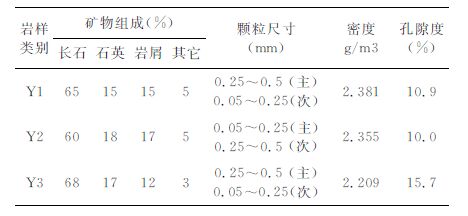
|
图 1
Y1岩样在干燥、饱水及饱油情况下V |
图 2是Y2砂岩样品在干燥、饱水及饱油条件下Vp、Vs1和Vs2随压力变化的情况.不难看出,它们均随压力增加(或降低)而以对数曲线增大(或减小),这和Y1相似;但在三种波速间的关系方面,却有不尽相同的表现形式.对Vp 来说,其表现形式是:饱水>干燥>饱油,而Vs1和Vs2则是:干燥>饱水>饱油.
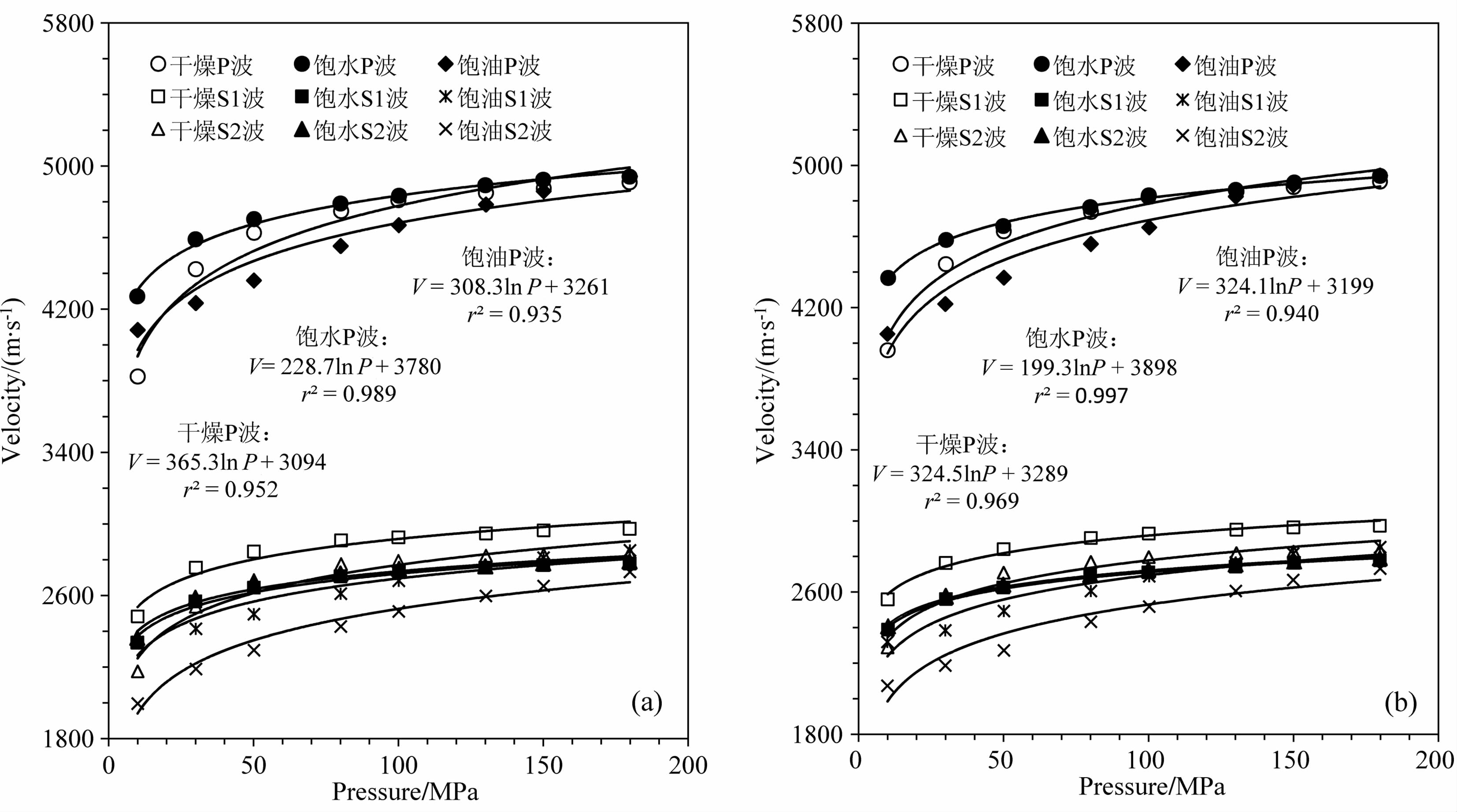
|
图 2 Y2岩样在干燥、饱水及饱油情况下Vp、Vs1和Vs2与压力P的关系 (a) 升压过程;(b)降压过程. Fig. 2 P-and S-wave velocity in dry,water and oil saturated conditions changing with pressure for sample Y2 (a) Process of increasing the pressure; (b) Process of decreasing the pressure. |
图 3是Y3砂岩样品在干燥、饱水及饱油条件下Vp、Vs1和Vs2随压力变化的情况.很明显,它们均随压力增加(或降低)而以对数曲线增大(或减小),这点同Y2和Y1相似;但在三种波速的关系方面则有自己的独特之处.对Vp 来说,其表现特征为:饱油≈干燥> 饱水;而Vs1和Vs2则是:干燥> 饱油>饱水.

|
图 3 Y3岩样在干燥、饱水及饱油情况下VpVsl和Vs2与压力P的关系 (a)升压过程;(b)降压过程. Fig. 3 P-and S-wave velocity in dry,water and oil saturated conditions changing with pressure for sample Y3 (a) Process of increasing the pressure; (b) Process of decreasing the pressure. |
图 4— 6是Y1、Y2和Y3岩样分别在干燥、饱水及饱油条件下Vp、Vs1和Vs2随压力变化的对比情况.可以看出,不管在哪种孔隙流体条件下,三种岩样Vp 间的关系均表现为:Y1≥Y2>Y3.
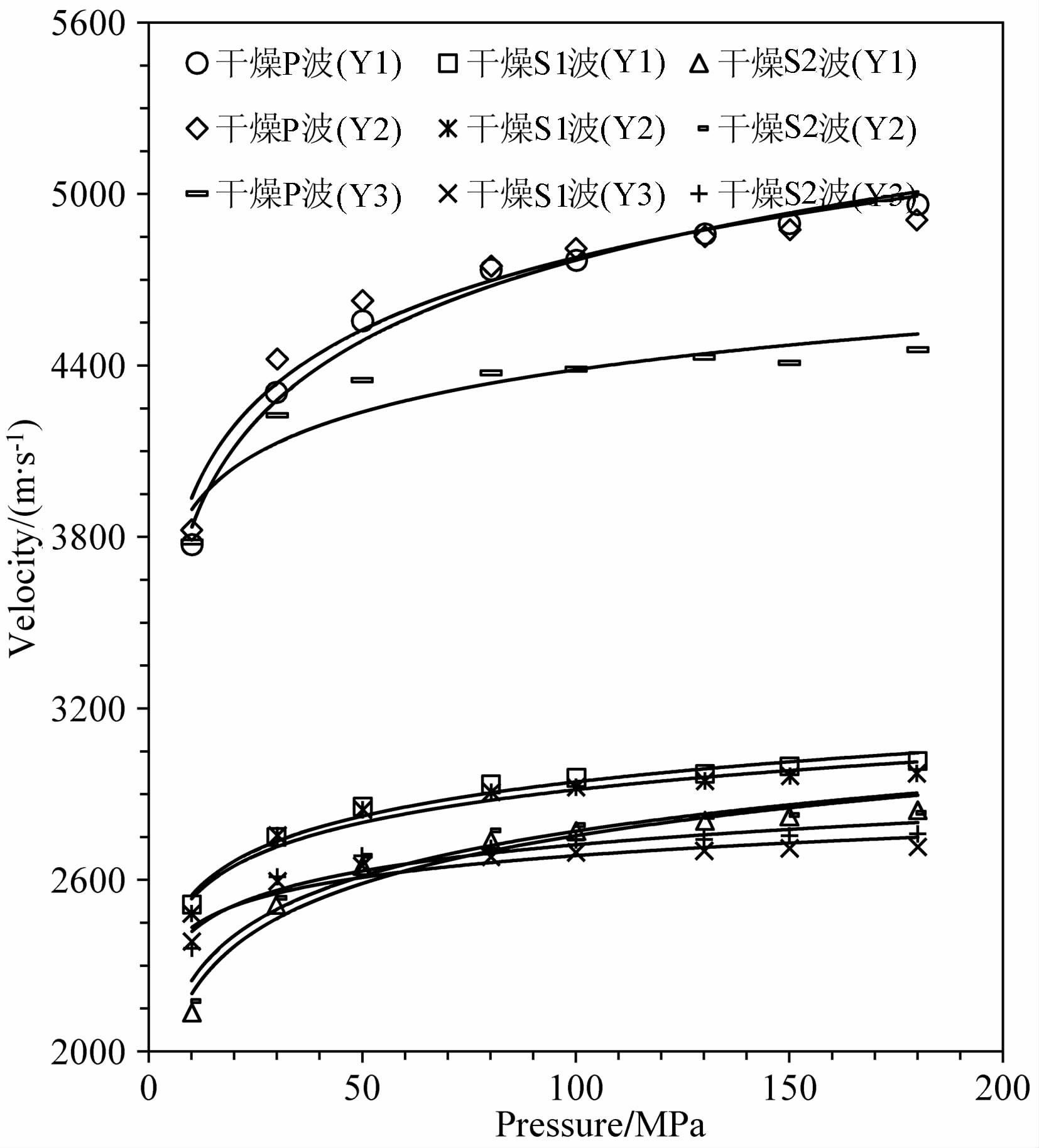
|
图 4 Yl,Y2及Y3岩样在干燥条件下 Vp、Vsl和Vs2与压力P的关系 Fig. 4 P-and S-wave velocity in dry conditions changing with pressure for samples Yl,Y2 and Y3 |
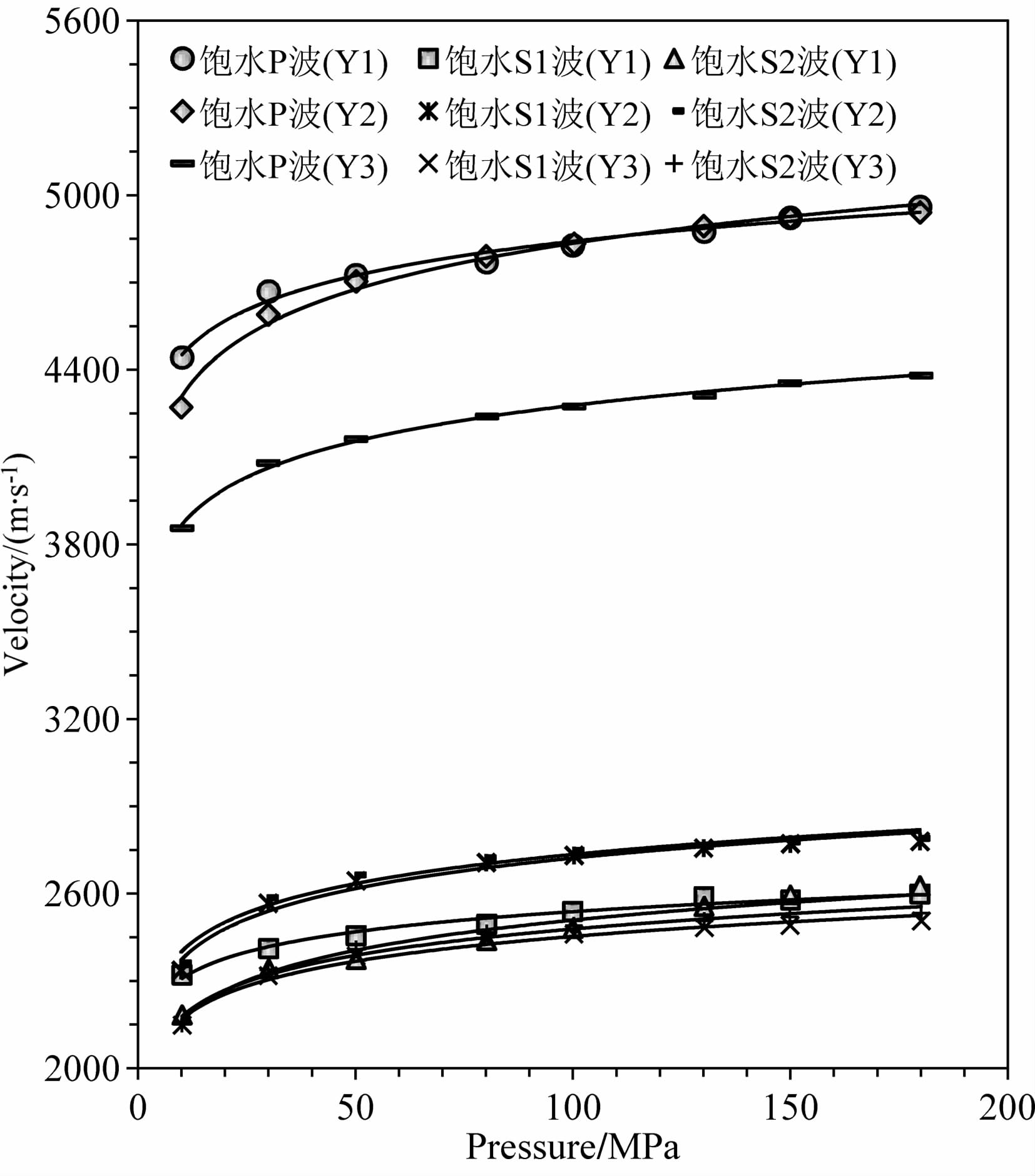
|
图 5 Y1,Y2及Y3岩样在饱水条件下、Vsl和Vs2与压力P的关系 Fig. 5 P-and S-wave velocity in water saturated conditions changing with pressure for samples Y1,Y2 and Y3 |
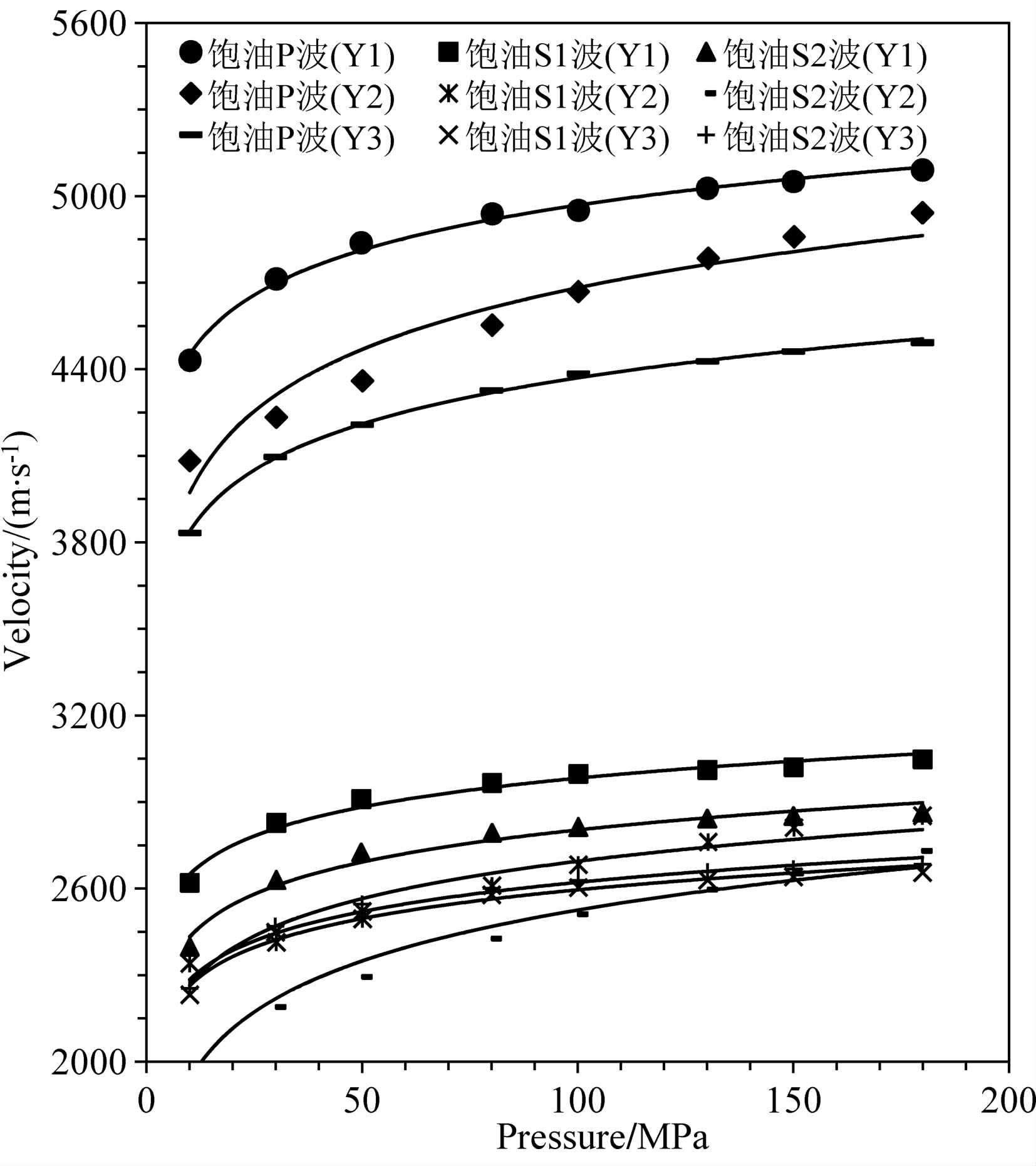
|
图 6 Y1,Y2及Y3岩样在饱油条件下 Vp 、Vsl和Vs2与压力P的关系 Fig. 6 P-and S-wave velocity in oil saturated conditions changing with pressure for samples Y1 ,Y2 and Y3 |
上述结果可根据弹性波速度公式[37]进行解释.

|
(1) |

|
(2) |
其中:K─介质的体积模量;μ─ 介质的剪切模量;ρ─密度.岩样中的饱和水或油会从两方面影响其中传播的纵波、横波速度:一是岩石内部孔隙充满水或油会增大样品的有效体积模量和剪切模量,使波速增大;二是孔隙内充水或油会加大样品的密度值,使波速变小.
对Y1的Vp 来说,低压下饱和水或油会使样品的有效弹性模量增加起主要作用.根据式(1),此时的Vp 均比干燥状态下的大,所对应的波速曲线在干燥之上(图 1).随压力增加,样品的密度增大效应逐渐显著,同样由式(1)可知,Vp 增大的幅度会逐渐缩小,与干燥之间的差距也在缩小,三条波速曲线逐渐接近.当压力增加到约130 MPa时,饱水与干燥曲线相交;此后二者基本一致,直至压力增大到约150 MPa后,干燥曲线位于饱水之上.另外,由于油的粘滞系数比水大,密度比水小,相对而言,饱和油会使样品的有效弹性模量增加更显著,而密度增大效应则较弱,所以饱油条件下的Vp 比饱水的大(图 1a).
Vs 的情况相对复杂.饱和水使样品密度增大起主要作用,由式(2)及油水物理性质的差异可知,此时的Vs1和Vs2和饱油及干燥状态相比是最小的.而饱油样品在低压力下是弹性模量增加效应起主要作用,根据式(2),其Vs1 和Vs2 均比相对应的干燥的大;随着压力上升,密度增大效应开始逐渐显著,两者之间的差距越来越小,两种曲线逐渐接近并近似平行.另外,高压下尤其是100 MPa以上,饱水Vs1和Vs2基本没有差异,说明此时影响二者的外部因素已趋相同(图 1a).
以上所说的是升压过程,降压过程的情况基本与此一致.唯一不同的是当压力降到100 MPa以下时,与对应的升压过程相比,饱水Vp 变化幅度过快(图 1),这也可以从图 1给出的拟合公式中看出.之所以产生这种差异,是由于岩样中的水在降压过程中出现了部分漏失(图 7).
图 7是Y1岩样饱水与饱油升、降压过程中Vp曲线的对比.可以看出,在压力降到约150 MPa时,饱水样品第一次漏失,正是这次漏失导致其弹性模量增加的效应减弱,Vp 下降幅度加大;在100MPa左右时的再次漏失,更加剧了Vp的下降幅度(图 1b).另外,从图 1a和1b的对比也可以看出,Vs1和Vs2均没有明显的变化.说明岩样中含水量的变化对它们基本没有影响,也即岩样含水饱和度的变化对Vs1和Vs2基本没有影响.这一点与施行觉等[36, 38]的研究结果一致.
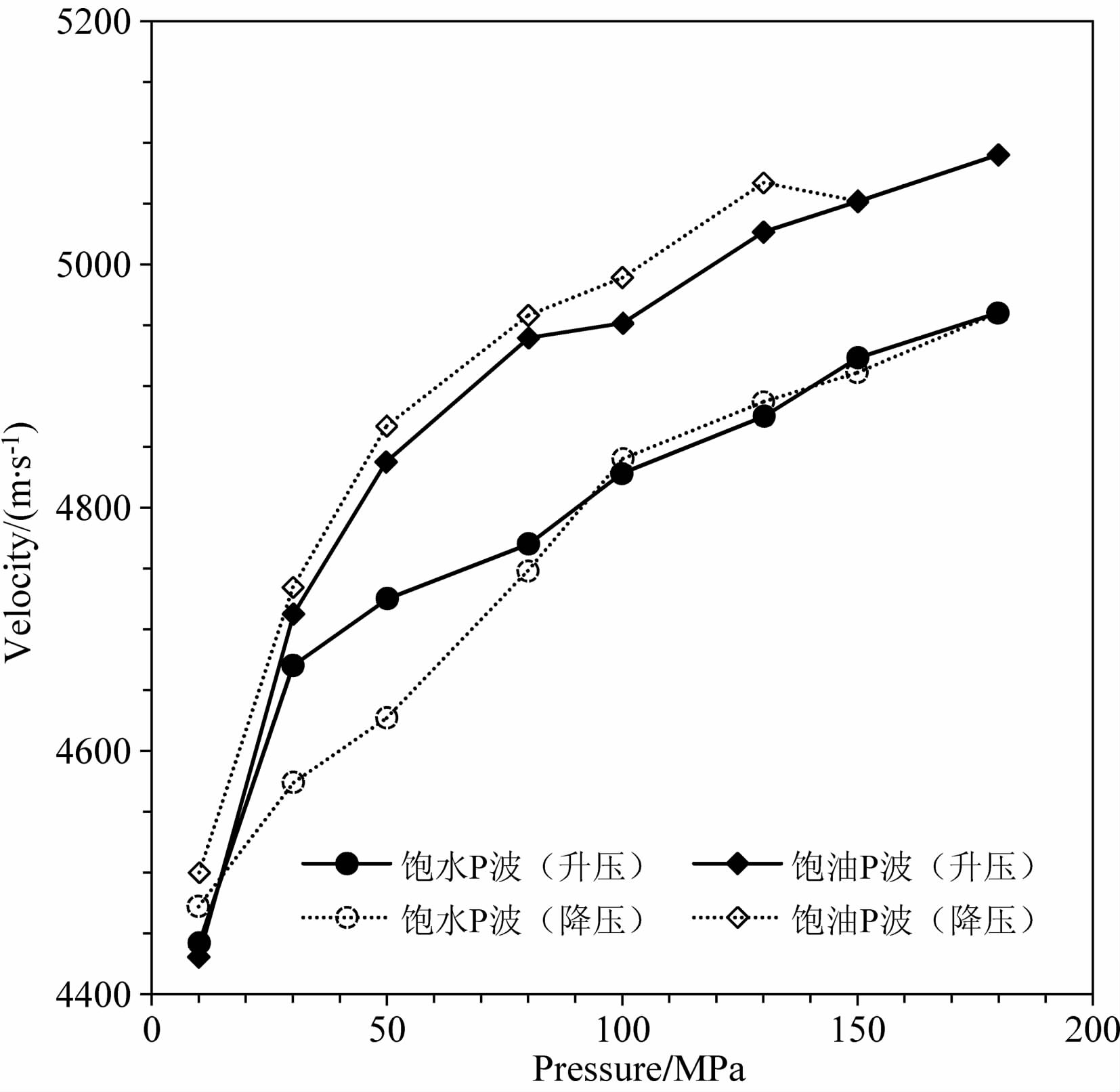
|
图 7 图7 Y1岩样在饱水及饱油情况下Vp与压力P的关系 Fig. 7 P-wave velocity in water and oil saturated conditions changing with pressure for sample Y1 |
另外,从图 1—图 3 也可以看出,所有的纵波、横波在0~50 MPa段,波速随压力增加较快,明显呈非线性变化,这是由于裂隙和孔隙的闭合引起的[39-49].虽然不同类型砂岩增加的幅度不尽相同,但这一变化却是十分显著的;在压力超过50 MPa后,由于岩石的裂隙和孔隙基本闭合,波速增加呈斜率不同的线性曲线,且变化非常小,可以代表真实的岩石地震波特性.由于总体上波速随压力呈对数曲线变化,为方便说明,本文没有按压力进行分段拟合.
对Y2砂岩来说,干燥、饱水和饱油波速间的关系明显不同于Y1.其主要原因是:
1) Y2和Y1类砂岩的粒度不同.从表 1和图 8可以看出,Y2 以细沙为主,区别于以中砂为主的Y1.较细颗粒比粗粒所形成的孔隙更狭小,也更容易使充填的油被压实,从而促使密度增大的效果更明显,进而导致Y2 饱油波速随压力增加而上升的幅度低于饱水和干燥.但饱水和干燥波速并不受粒度变化的影响,因此,它们之间的关系和对应的Y1相比,基本保持不变.

|
图 8 实验样品显微照片 (a) Yl样品;(b) Y2样品.标有”Qtz、Fsp、Bt和Deb”的矿物颗粒分别是石英、长石、黑云母和岩屑. Fig. 8 Microscopic photographs for sample Yl (a) and Y2 (b) The mineral grains marked with Qtz,Fsp,Bt and Deb are quartz,feldspar,biotite and debris,respectively. |
2) 含油饱和度可能较低.较低的含油饱和度使样品有效弹性模量增加的效果不明显,进而影响到其波速的增加.而这一切归根到底是由Y2 的细粒结构所形成的狭小孔隙引起的,因为狭小孔隙不利于粘度相对较大的油进入,因此同样的岩样,含油和含水饱和度相比会较低.
总之,Y2同Y1三种波速间关系差异的主要原因是由于二者孔隙结构不同,而这一切则是由不同的粒度所引起的.
另外,从图 2a和2b的对比可以看出,降压过程中Vp 的变化幅度存在异常.其原因与Y1 相似,不同的是除了饱水样品漏失外,饱油样品也出现了漏失(图 9),但两者的漏失对Vs1和Vs2都没有太大的影响.同Y1一样,说明含水或含油饱和度的变化对Vs1和Vs2没有太大的影响.
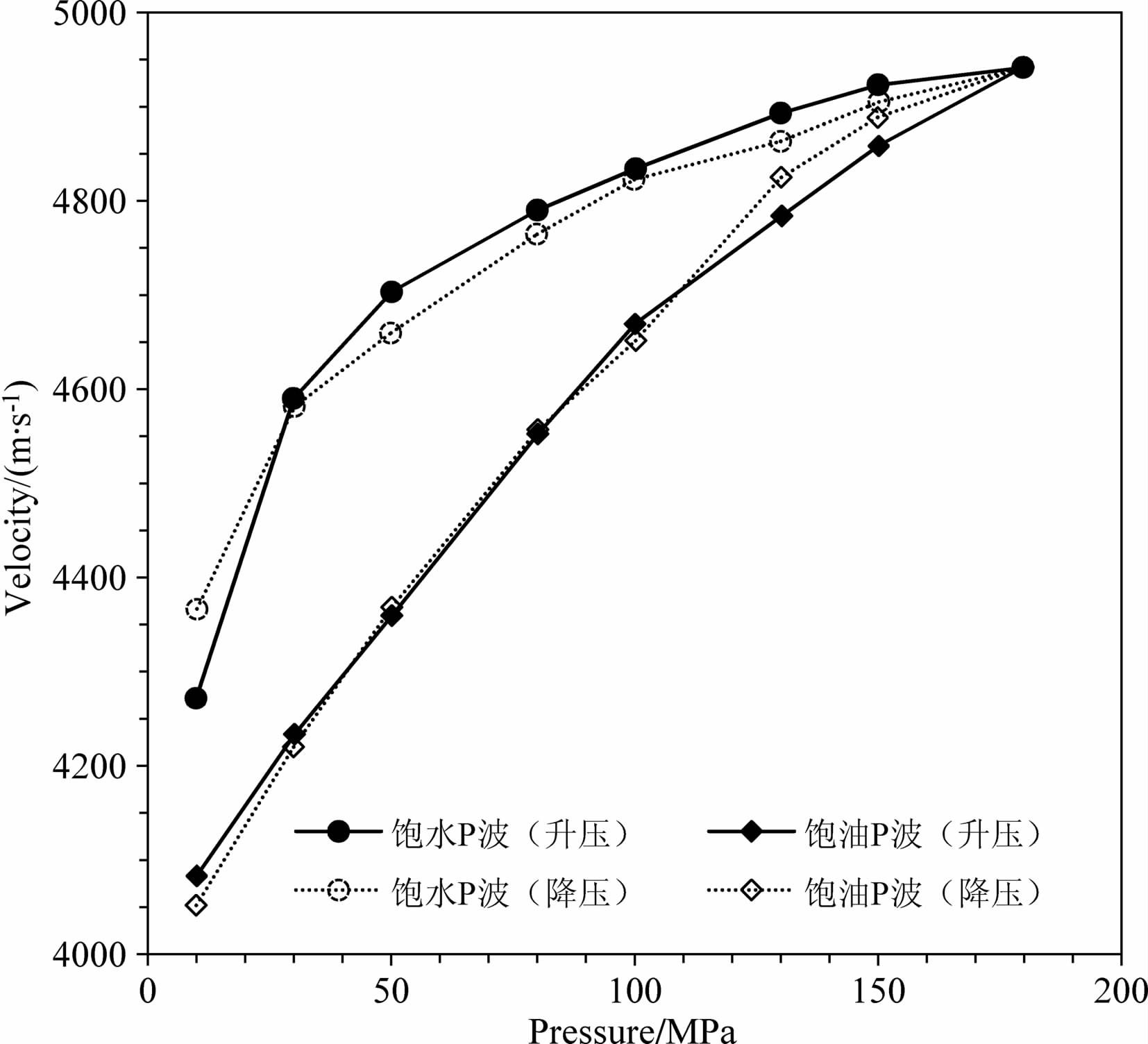
|
图 9
Y2岩样在饱水及饱油情况下Vp与压力P |
对Y3 来说,三种波速间的关系既不同于Y1,也不同于Y2,其内在原因可能与Y3具有较大的孔隙度(表 1)有关.因为岩样充水或充油后,较大孔隙度会更容易使其密度增大的效应起主导作用.这样,随着压力上升,其波速增加趋势也会大幅减缓.由于水比油密度大,因此它对波速的影响也会更突出.所以不管对Vp或Vs1和Vs2来说,饱水是三种波速中最小的(图 3).
由于降压过程中饱油和饱水样品都出现了漏失(图 10),导致这两种Vp的变化幅度均大于相对应的上升过程(图 3a,b).另外,同Y1 和Y2 一样,饱油及饱水的Vs1和Vs2在升降过程中没太大变化,说明含油或含水量的变化对其没有产生明显的影响,也就说含水或含油饱和度的变化对Vs1和Vs2基本没有影响.
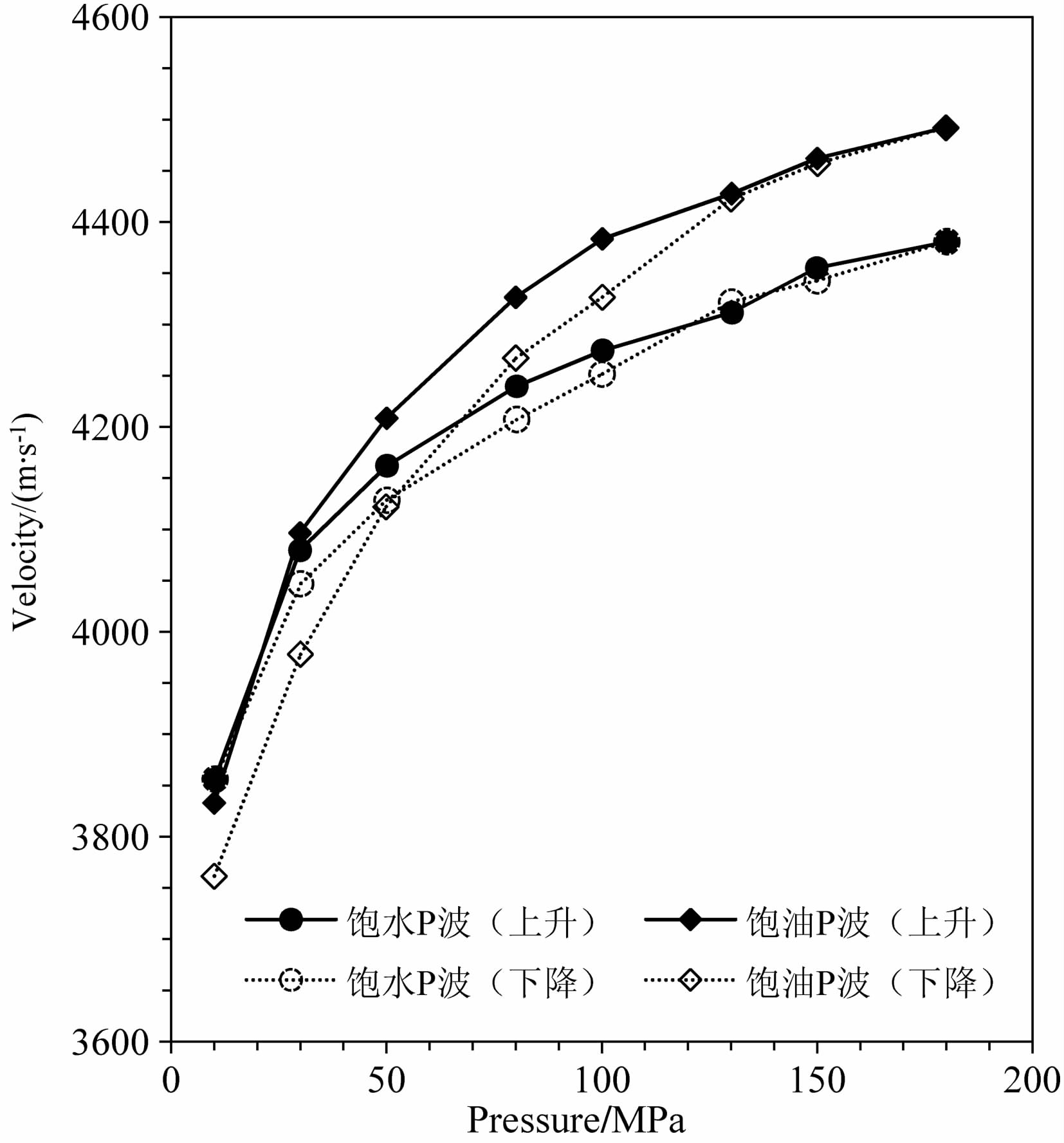
|
图 10 Y3岩样在饱水及饱油情况下Vp与压力P的关系 Fig. 10 P-wave velocity in water and oil saturated conditions changing with pressure for sample Y3 |
另外,由以上可知,Y3 以其孔隙度较大而区别于Y1和Y2,而Y2则以较细粒度而不同于Y1.因此,我们可以推测出:较大孔隙度是引起Vp 下降最主要的因素,其次是较细粒度.Vs1和Vs2的情况相对较复杂.一般来说,较大孔隙度是引起Vs下降的主要因素,其次是较粗粒度(饱水条件).
5 结 论由本实验可以得出如下认识:
1) 三种砂岩样品Y1、Y2和Y3的Vp、Vs1和Vs2均随压力增加(或降低)而基本呈对数曲线增大(或减小),且相关系数基本都在90% 以上(除Y3 的干燥Vp 外).
2) 干燥、饱水和饱油三种波速间的关系因砂岩类型不同而不同,这主要取决于岩石的有效弹性模量、孔隙流体性质(密度、粘滞系数)以及岩石的内部结构(粒度、孔隙)等.
3) 含不同孔隙流体的同种砂岩,其Vp、Vs1 和Vs2随压力变化的规律也不尽相同.基本的影响因素有:有效弹性模量、密度、粘滞系数等,其中有效弹性模量、密度为主要因素.
4) 含同种孔隙流体的不同类砂岩,其Vp、Vs1和Vs2随压力变化的规律也不同.主要的影响因素是孔隙度,其次是粒度.其中孔隙度与Vp、Vs 分别呈负相关性.
5) 含水或含油饱和度的变化对Vs1和Vs2基本没有影响.
6) Vp、Vs1和Vs2随压力及不同孔隙流体的变化规律,可以为该地区地震资料的解释及与声波测井之间的对比提供基础数据和参考,同时也为深部地球物理探测成果的正确解译提供依据.
致谢本文的实验工作得到了地质力学所王红才研究员、孙东生助理研究员、史向前工程师和孙宁工程师等的支持与帮助,北京大学郑海飞教授对本文提出了宝贵的修改意见,在此一并表示感谢!
| [1] | Christensen N I, Mooney W D. Seismic velocity structure and composition of the continental crust. A global view|J| Geophy|Res| , 1995, 100(B6): 9761-9788. |
| [2] | Gao S, Kern H, Liu Y, et al. Measured and calculated seismic velocities and densities for granulites from xenolith occurrences and adjacent exposed lower crustal sections:a comparative study from the North China craton. J|Geophy|Res| , 2000, 105(B8): 18965-18976. |
| [3] | Park J, Levin V. Seismic anisotropy:tracing plate dynamics in the mantle. Science , 2002, 296(5567): 485-489. DOI:10.1126/science.1067319 |
| [4] | Rudnick R L, Fountain D M. Nature and composition of the continental crust. A lower crustal perspective|Rev|Geophy , 1995, 33(3): 267-309. |
| [5] | Weiss T, Siegesmund S, Rabbel W, et al. Seismic velocities and anisotropy of the lower continental crust. A review| Pure appl| Geophys , 1999, 156(1-2): 97-122. |
| [6] | 嵇少丞, 王茜, 王勤, 等. 苏鲁—大别超高压变质岩的弹性力学性质与密度关系. 岩石学报 , 2007, 23(12): 3054–3064. Ji S C, Wang Q, Wang Q, et al. Correlation between elastic properties and density for Sulu-Dabie UHP metamorphic rocks. Acta Petrologica Sinica (in Chinese) , 2007, 23(12): 3054-3064. |
| [7] | 嵇少丞, 王茜, 许志琴. 苏鲁超高压变质岩中地震波速随压力的变化规律. 地质学报 , 2006, 80(12): 1807–1812. Ji S C, Wang Q, Xu Z Q, et al. Pressure-Dependence of P-Wave Velocities in Sulu UHP Metamorphic Rocks. Acta Geologica Sinica (in Chinese) , 2006, 80(12): 1807-1812. |
| [8] | 王勤. 岩石地震波性质的实验与理论研究. 矿物岩石地球化学通报 , 2007, 26(2): 118–126. Wang Q. Experimental and theoretical study on seismic properties of rocks. Bulletin of Mineralogy. Petrology and Geochemistry (in Chinese) , 2007, 26(2): 118-126. |
| [9] | Timur A. Temperature dependence of compressional and shear wave velocities in rocks. Geophysics , 1977, 42(5): 950-956. DOI:10.1190/1.1440774 |
| [10] | 曹均, 贺振华, 黄德济, 等. 储层孔(裂)隙的物理模拟与超声波实验研究. 地球物理学进展 , 2004, 19(2): 386–391. Cao J, He Z H, Huang D J, et al. Physical modeling and Ultrasonic experiment of pore-crack in reservoirs. Progress in Geophys| (in Chinese) , 2004, 19(2): 386-391. |
| [11] | Batzle M L, Wang Z. Seismic properties of pore fluids. Geophysics , 1992, 57(11): 1396-1408. DOI:10.1190/1.1443207 |
| [12] | Best A I. The effect of pressure on ultrasonic velocity and attenuation in near-surface sedimentary rocks. Geophysical Prospecting , 1997, 45(2): 345-364. DOI:10.1046/j.1365-2478.1997.00344.x |
| [13] | 陈祖安, 伍向阳. 砂岩孔隙度和含泥量与波速关系的模型. 地球物理学进展 , 2000, 15(1): 78–82. Chen Z A, Wu X Y. A model for the relation between wave velocity and porosity as well as clay content in sandstone. Progress in Geophys| (in Chinese) , 2000, 15(1): 78-82. |
| [14] | 李爱兵, 马丽云. 频率、温度对砂岩的横波速度和值的影响. 地球物理学报 , 1994, 37(5): 653–658. Li A B, Ma L Y. Effects of frequency and temperature on shear velocity and Q-s in sandstone. Chinese J| Geophys| (in Chinese) , 1994, 37(5): 653-658. |
| [15] | 卢琳, 闫桂京, 陈建文. 地层温度和压力对地震速度的影响. 海洋地质动态 , 2005, 21(9): 13–16. Lu L, Yan G J, Chen J W. Influences of temperature and pressure on velocities of seismic. Marine Geology Letters (in Chinese) , 2005, 21(9): 13-16. |
| [16] | 姜修道, 朱光明. 变质岩区地震波速度的特点及其影响因素——以中国大陆科学钻探孔区为例. 地球物理学进展 , 2003, 18(2): 331–335. Jiang X D, Zhu G M. Characteristics and effect factors of seismic velocity in metamorphic rock area: An example from CCSD borehole area. Progress in Geophys| (in Chinese) , 2003, 18(2): 331-335. |
| [17] | Khaksar A, Grifiths C M, McCann C. Compressional- and shear-wave velocities as a function of confining stress in dry sandstones. Geophysical Prospecting , 1999, 47(4): 487-508. DOI:10.1046/j.1365-2478.1999.00146.x |
| [18] | 马中高, 解吉高. 岩石的纵、横波速度与密度的规律研究. 地球物理学进展 , 2005, 20(4): 905–910. Ma Z G, Xie J G. Relationship among conpressional wave, shear wave velocities and density in rocks. Progress in Geophys| (in Chinese) , 2005, 20(4): 905-910. |
| [19] | 史謌, 杨东全. 岩石波速和孔隙度、泥质含量之间的关系研究. 北京大学学报( 自然科学版) , 2001, 37(3): 379–384. Shi G, Yang D Q. The regression analysis study on velocity and porisity, and clay content of rocks. Acta Scientiarum Naturalium Universitatis Pekinensis (in Chinese) , 2001, 37(3): 379-384. |
| [20] | 史謌, 沈文略, 杨东全. 岩石弹性波速度和饱和度、孔隙流体分布的关系. 地球物理学报 , 2003, 46(1): 138–142. Shi G, Shen W L, Yang D Q. The relationship of wave velocities with saturation and fluid distribution in pore space. Chinese J| Geophys| (in Chinese) , 2003, 46(1): 138-142. |
| [21] | 李琳, 马劲风, 张宪旭. 孔隙裂隙型砂岩横波速度预测方法. 地球物理学进展 , 2010, 25(3): 1065–1074. Li L, M J F, Zhang X X. S-wave velocity prediction in sandstones. Progress in Geophys| (in Chinese) , 2010, 25(3): 1065-1074. |
| [22] | 刘斌, KernH, PoppT. 不同压力下孔隙度不同的干燥及水饱和岩样中的纵横波速度及衰减. 地球物理学报 , 1998, 41(4): 537–546. Liu B, Kern H, Popp T. Velocities and attenuation of P- and S-waves in dry and wet rocks with different porosities under different confining pressures. Chinese J| Geophys| (in Chinese) , 1998, 41(4): 537-546. |
| [23] | 伍向阳, 方华, 陈祖安. 储层砂岩声波速度预测. 地球物理学进展 , 1999, 14(1): 56–63. Wu X Y, Fang H, Chen Z A. Estimation of wave velocities of sandstones. Progress in Geophys| (in Chinese) , 1999, 14(1): 56-63. |
| [24] | 肖昆, 邹长春, 聂昕. 江苏油田G凹陷储层条件下岩石纵横波速度实验研究. 工程地球物理学报 , 2010, 7(6): 688–693. Xiao K, Zou C C, Nie X, et al. Experimental research of S-wave and P-wave velocities for rocks under the reservoir conditions in G sag, Jiangsu Oilfield. Chinese Journal of Engineering Geophysics (in Chinese) , 2010, 7(6): 688-693. |
| [25] | 杨宏峰, 施行觉. 轴向压力下砂岩波速的实验研究. 地球物理学进展 , 2004, 19(2): 481–485. Yang H F, Shi X J. Experimental research on wave velocity under axial pressure. Progress in Geophys| (in Chinese) , 2004, 19(2): 481-485. |
| [26] | 张友南, 李彪. 山西裂谷带地壳岩石波速的研究. 地球物理学进展 , 1993, 84(5): 214–224. Zhang Y N, Li B. Investigation of wave velocity of crustal rocks in shanxi rift zone. Progress in Geophys| (in Chinese) , 1993, 84(5): 214-224. |
| [27] | 孙建国. 岩石物理学基础. 北京: 地质出版社, 2006 . Sun J G. Rock Physics (in Chinese). Beijing: Geology Press, 2006 . |
| [28] | 马麦宁, 白武明, 伍向阳. 10.6~1.5 GPa、室温~1 200 ℃条件下青藏高原地壳岩石弹性波速特征. 地球物理学进展 , 2002, 17(4): 684–689. Ma M N, Bai W M, Wu X Y. Study on elastic wave velocities of crustal rocks under high temperature and high pressure conditions. Progress in Geophys. (in Chinese) , 2002, 17(4): 684-689. |
| [29] | 邓继新, 王尚旭, 俞军. 不同压力条件下部分饱和砂岩速度实验结果及理论解释. 石油地球物理勘探 , 2005, 40(5): 530–534. Deng J X, Wang S X, Yu J. Experimental results in partially saturated sandstone under condition of different pressure and their theoretical interpretation. Oil Geophysical Prospecting (in Chinese) , 2005, 40(5): 530-534. |
| [30] | 孙东生, 李阿伟, 王红才, 等. 低渗砂岩储层渗透率各向异性规律的实验研究. 地球物理学进展 , 2012, 27(3): 1101–1106. Sun D S, Li A W, Wang H C, et al. Experiment on anisotropy of permeability with tight sandstone. Progress in Geophys| (in Chinese) , 2012, 27(3): 1101-1106. |
| [31] | He T, Zou C, Pei F, et al. Laboratory study of fluid viscosity induced ultrasonic velocity dispersion in reservoir sandstones. Applied Geophysics , 2010, 7(2): 114-126. DOI:10.1007/s11770-010-0235-3 |
| [32] | Purcell C, Mur A, Soong Y, et al. Integrating velocity measurements in a reservoir rock sample from the SACROC unit with an AVO proxy for subsurface supercritical CO2. The Leading Edge , 2010, 29(2): 192-195. DOI:10.1190/1.3304823 |
| [33] | Mur A, Purcell C, Soong Y, et al. Integration of core sample velocity measurements into a 4D seismic survey and analysis of SEM and CT images to obtain pore scale properties. Energy Procedia , 2011, 4: 3676-3683. DOI:10.1016/j.egypro.2011.02.299 |
| [34] | 马麦宁, 白武明. 高温高压实验弹性波速研究及其地球动力学意义. 地球物理学进展 , 1999, 14(1): 40–55. Ma M N, Bai W M. Progress of high temperature and pressure study on elastic wave velocity and its geodynamicalimplications. Progress in Geophys| (in Chinese) , 1999, 14(1): 40-55. |
| [35] | Hornby B E. Experimental laboratory determination of the dynamic elastic properties of wet, drained shales. Journal of Geophysical Research , 1998, 103(B12): 29945-29964. DOI:10.1029/97JB02380 |
| [36] | 施行觉, 夏从俊, 吴永钢. 储层条件下波速的变化规律及其影响因素的实验研究. 地球物理学报 , 1998, 41(2): 234–241. Shi X J, Xia C J, Wu Y G. The laboratory study on wave velocity under reservoir condition and its affection factors. Chinese J| Geophys| (in Chinese) , 1998, 41(2): 234-241. |
| [37] | 马沃克葛瑞, 木克基塔基, 德沃金著杰克. 岩石物理手册:孔隙介质中地震分析工具 , 2008. Mavko G, Mukerji T, Dvorkin J. The Rock Physics Handbook: Tools for Seismic Analysis of Porous Media(in Chinese). Translated by Xu H B, Dai J C. Hefei: Press of University of Science and Technology of China (in Chinese) , 2008. |
| [38] | 施行觉, 徐果明, 靳平. 岩石的含水饱和度对纵、横波速及衰减影响的实验研究. 地球物理学报 , 1995, 38(Supp.1): 281–287. Shi X J, Xu G M, Jin P, et al. The laboratory study of influence of water saturation on rock s velocity and attenuation. Chinese J| Geophys| (in Chinese) , 1995, 38(Supp.1): 281-287. |
| [39] | Birch F. The velocity of compressional waves in rocks to 10 kilobars, part 2. Journal of Geophysical Research , 1961, 66(7): 2199-2224. DOI:10.1029/JZ066i007p02199 |
| [40] | Carlson R L, Gangi A F. Effect of cracks on the pressure dependence of p wave velocities in crystalline rocks. Journal of Geophysical Research , 1985, 90(B10): 8675-8684. DOI:10.1029/JB090iB10p08675 |
| [41] | David E C, Zimmerman R W. Pore structure model for elastic wave velocities in fluid-saturated sandstones. Journal of Geophysical Research , 2012, 117(B07210): 1-15. |
| [42] | 郝晋昇, 刘晓红, 李纪汉. 华北地区典型岩石在1万巴压力下的密度和弹性波速度的实验研究. 地震学报 , 1985, 7(3): 276–284. Hao J S, Lu X H, Li J H. An experimental study on the density and elastic wave velocity of typical rocks of north china under high pressure up to 10kb. Acta Seismologica Sinica (in Chinese) , 1985, 7(3): 276-284. |
| [43] | Higo Y, Inoue T, Li B, Irifune T, Liebermann R C. The effect of iron on the elastic properties of ringwoodite at high pressure. Physics of the Earth and Planetary Interiors , 2006, 159: 276-285. DOI:10.1016/j.pepi.2006.08.004 |
| [44] | Kern H T, Popp F, Gorbatsevich A. Smirnov Pressure and temperature dependence of Vp and Vs in rocks from the superdeep well and from surface analogues at Kola and the nature of velocity anisotropy. Tectonophysics , 2001, 338: 113-134. DOI:10.1016/S0040-1951(01)00128-7 |
| [45] | 李华, 王良书, 李成. 塔里木盆地岩石高温高压下波速的实验研究及其地质意义. 高校地质学报 , 2005, 11(4): 601–607. Li H, Wang L S, Li C, et al. Experimental study on wave velocity of rocks from tarim basin at high PT conditions and its geological implications. Geological Journal of China Universities (in Chinese) , 2005, 11(4): 601-607. |
| [46] | 刘永祥, 吴福元, 张世红. 高温高压下岩石弹性波速特征及其在深部地质研究中的意义. 地球物理学进展 , 1995, 10(3): 82–94. Liu Y X, Wu F Y, Zhang S H. The characteristics of elastic wave veloctty of rocks at high t and p: implications for the study of deepseated geology. Progress in Geophys| (in Chinese) , 1995, 10(3): 82-94. |
| [47] | 马中高, 伍向阳, 王中海. 有效压力对岩石纵横波速度的影响. 勘探地球物理进展 , 2006, 29(3): 183–186. Ma Z G, Wu X Y, Wang Z H. Effect of effective pressure on compressional and shear wave velocities. Progress in Exploration Geophysics (in Chinese) , 2006, 29(3): 183-186. |
| [48] | Sun S, Ji S, Wang Q, et al. Seismic velocities and anisotropy of core samples from the Chinese Continental Scientific Drilling borehole in the Sulu UHP terrane, eastern China. Journal of Geophysical Research , 2012, 117(B01206): 1-24. |
| [49] | 杨树锋, 陈汉林, 姜继双, 等. 高温高压下华南Ⅰ型和S型花岗岩的波速特征及其地质意义. 中国科学, D辑 , 1997, 27(1): 33–38. Yang S F, Cheng H L, Jiang J S, et al. The velocity characteristics and its geological significance of I and S type granite from Southern China under high temperature and high pressure. Science in China (Series D) (in Chinese) , 1997, 27(1): 33-38. |
 2012, Vol. 55
2012, Vol. 55

